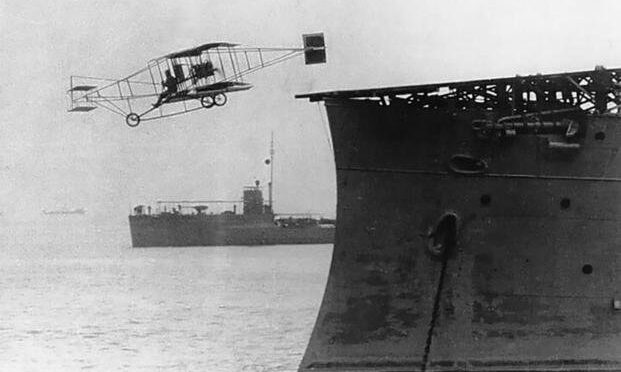By Brent D. Sadler
June 2024 marks the 90th year since commissioning the Ranger (CV-4), the first purpose-designed and built U.S. aircraft carrier. The Ranger stood on the legacies of several ships, most notably the converted collier Langley (CV-1), commissioned in 1922. A century of lessons learned from fleet experimentation during the interwar period, wartime experiences from World War Two, and the necessities of nuclear deterrence during the Cold War coalesced into today’s premier aircraft carrier, the Ford (CVN-78).
This legacy is more than just the evolution of the aircraft carrier as a ship; it represents a complex interaction between aircraft design, operational requirements driven by the battle space, and technology like nuclear propulsion. That said, there are consistencies throughout the evolution of the aircraft carrier: the importance of sortie rates, the advantage of longer operational range (for aircraft and ships), sensor coverage (to include scouting aircraft), and secure communications. As such, American aircraft carriers persevered over the challenge of Imperial Japan’s Kamikaze attacks, Soviet bomber long-range anti-ship cruise missiles, and will likely again over China’s anti-ship ballistic missiles. The bottom line is that the threats are not new, but how the carrier and its airwing evolve will determine its future. Contemporary nuclear-powered supercarriers, like the Ford, are built with a service life of 50 years, a timeframe equal to half the period aircraft carriers existed.
Today, the aircraft carrier faces evolving challenges and emerging technological opportunities. Amidst these challenging times, there is no single or clear picture of how these warships and their airwings will best perform in a modern blue-water war. However, with the next major war shaping up to be a modern replay of the last war in the Pacific, geography shows it is highly likely the aircraft carrier will play a leading role again, but not in traditional battle or strike group formations.
The fifty-year dilemma of today’s aircraft carriers and airwings is how to embrace various technological developments in unmanned platforms, long-range weapons, and new methods of processing massive amounts of targeting data. Wartime experience in the Pacific clarifies that getting this right is never assured. Building flexibility and adaptability is paramount for today’s aircraft carriers and airwing.
Introduction
Aircraft carrier design is based on a simple premise: launching, recovering, and sustaining aircraft at sea. In addition, a range of naval missions—strike, air defense, and submarine detection—influence naval aircraft design and inform carrier design and operations. It is an iterative process with successes and failures littered throughout the century of aircraft carriers’ existence.
Today, as historically, there are technologies weighing on the aircraft carrier and its airwing. For example, weapon systems can hold the aircraft carrier and its airwing at risk well outside its organic sensors and weapons range. Top of the threat list is the much-hyped Chinese anti-ship ballistic missile (e.g., DF-21, DF-26) with a range of more than 3,000 miles. These weapons were in steady development for almost 20 years, building on a similar Soviet weapon system of the Cold War. Today, the Houthis are employing anti-ship ballistic missiles to limited effect in the Red Sea, and China’s military is certainly taking note to improve its designs and operational concepts. Chinese air-to-air weapons outrange today’s U.S. airwings with anti-air missiles like the PL-15 or newer PL-17, with ranges of around 186 miles, and exacerbate kinematic shortcomings. Importantly, weapons’ range is only effective if fed with precise targeting. Weapon evolution is nothing new, and the carriers and their airwings evolved to overcome such threats in the past. For example, the AIM-54C “Phoenix” air-to-air missile was developed to defeat Soviet Backfire bombers before reaching its weapons’ launch range against the carriers.
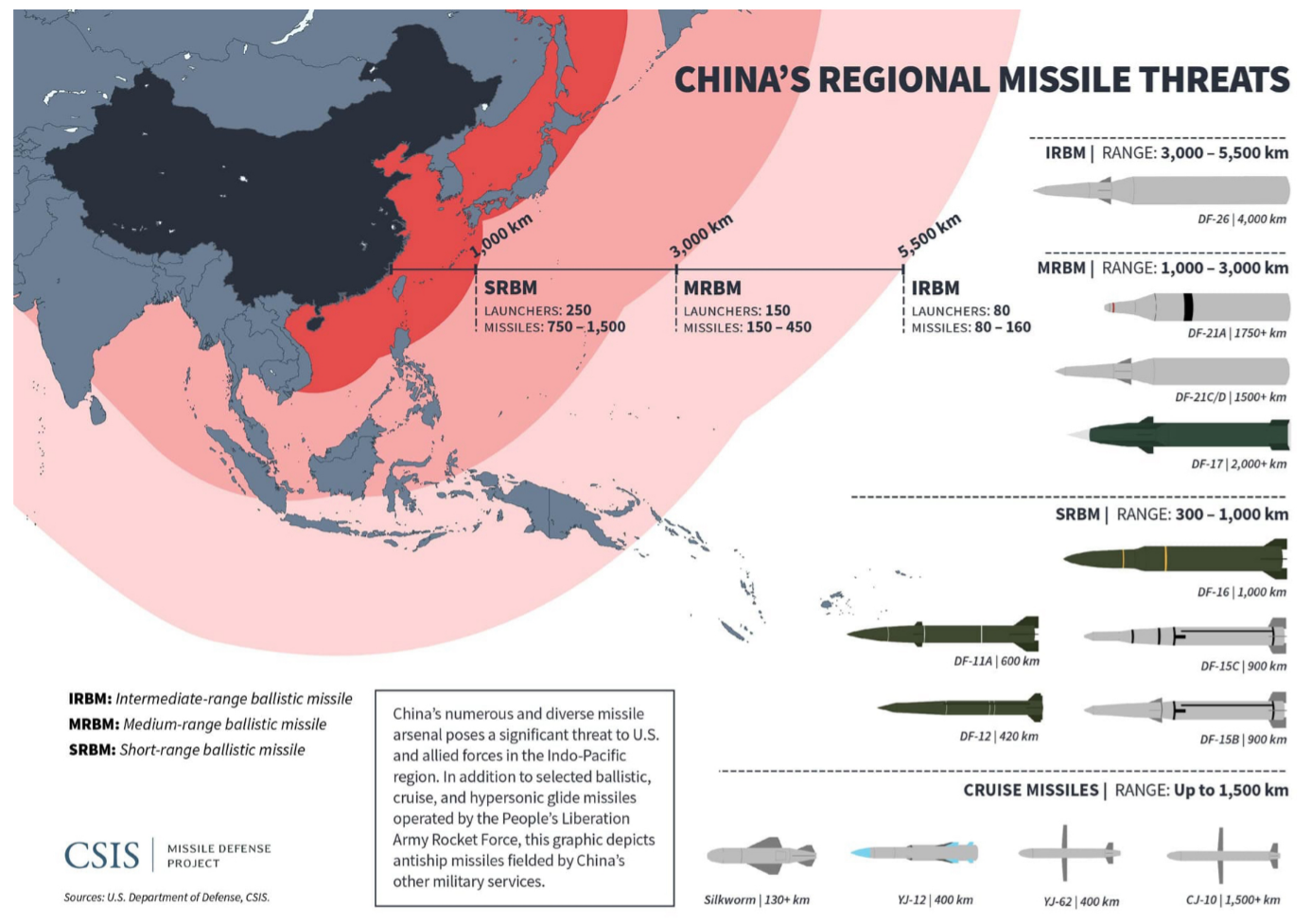
The ability to make sense of massive amounts of networked sensor data is rapidly evolving for attack and defense. Effectively placing a weapon on a target hundreds of miles away or defending against such an attack is a team effort. Vital to success is the ability to reliably connect various platforms and sensors across hundreds of miles and rapidly process copious data. The key to these efforts is artificial intelligence and big data management systems to focus and speed up human decision-making. Networking the naval and even proximate land and space assets together is widely recognized as fundamental to success on the battlefield today and well into the future. Thus, it will be a key element of future carriers and their airwings.
A January 2024 Paris naval conference focused on how these forces will shape U.S. and allied navies’ next-generation aircraft carriers and naval airwings. For the host, the impending decision by the French Navy to determine the requirements for its next aircraft carrier loomed over many of the panels’ discussions.1 The U.S. Chief of Naval Operations reflected on 100 years of U.S. aircraft carrier experience: “…one thing that you really see from carrier aviation and carrier strike groups is their adaptability.” The theme resonated throughout the conference and was echoed in the over 40 submitted papers for review, which informed the event’s numerous panels. Adaptability is a common feature of successful warship designs in naval warfare. The history of the aircraft carrier, its airwing, and associated escort ships’ success is a testament to the persistent value of adaptability.
Aircraft carriers are a significant investment, costing over $13B and requiring a highly trained crew numbering in the thousands. As such, aircraft carriers are built to last 50 years and so must be adaptable. Fifty years ago, the U.S. Global Positioning System or networked fleet units did not exist. Today’s buzz concerns a fourth industrial revolution centered on quantum computing and artificial intelligence. Technology moves fast, and being adaptable is the only way to be ready. The best way to maintain adaptability in a naval warship is with ample space and excess power generation. Observers noted that after advanced electronic warfare systems modification, the Arleigh-Burke class Pinckney sported significant bulges on its superstructure to carry the added gear and new power systems that did not fit into the already full ship.2
Milestones in Aircraft Carrier and Airwing Design
The evolution of the aircraft carrier and its airwing can be boiled down into three evolutionary periods: creation, experimentation, and adaptation. Importantly, adaptation can be broken down into two periods: wartime, notably in the Pacific, and the Cold War. Finally, a fourth era, which arguably we are in today, could be called tessellation or the covering of a space without gaps. Before diving into what tessellation implies for the future of the aircraft carrier and its airwing, a brief overview of the earlier evolutionary periods is informative.
The Age of Creation
The evolution of the aircraft carrier shortly followed aircraft entering the battlefield. For the U.S. Navy, the origin story of the aircraft carrier began with the successful takeoff and landing on an improvised at-sea platform by a plane piloted by Eugene Ely. In 1912, the first U.S. naval aviation unit was established. By 1914, the naval aviation unit was connected to the warships’ command and control network with the adoption of radio.3 However, it would be the U.K.’s improvisation to fight the First World War’s German submarine threat that saw the first viable aircraft carriers put to sea.
The first true aircraft carrier to enter service was the British warship Argus, a repurposed Italian cruise liner whose construction was halted in 1916. The Argus was put to sea in 1918, and it was too late to see combat, but its impact on Japanese and American navies was immense. Three design issues surfaced in this first aircraft carrier: speed, stability, and obstruction to flight operations from the exhaust stacks. In the case of Argus, modifications to the initially very stable cruise liner made the ship top-heavy and prone to rolls that imperiled flight operations. Smoke and physical obstruction from the exhaust stacks were remedied by placing them under the flight deck and aft. This was not a perfect solution, but it was workable. This solution also helped the third challenge, speed. For the underpowered airplanes of the day, wind speed over the flight deck to takeoff required a ship’s speed of 30 to 35 knots. Early wind tunnel studies showed that if the exhaust stacks had been above the flight deck, it would have caused unacceptable amounts of cross-deck turbulence. In 1918, flight trials were conducted with a canvas dummy island installed. With an island structure, the pilots found it easier to judge distances on landing.4 Many of these lessons informed the next era in aircraft carrier and airwing development.
The Age of Experimentation
1922 marked the beginning of a nearly 20-year process of experimentation and design improvements to the aircraft carrier and its airwing. That year, the Langley (CV-1) entered service as the first U.S. aircraft carrier after a two-year conversion from a collier. She became a test platform for naval aircraft carriers and airwing operations until her conversion to a seaplane tender in 1937, as a war in the Pacific loomed. During this timeframe, she was joined by the much larger converted cruisers Lexington and Saratoga. Through a series of major naval exercises called “Fleet Problems,” the Navy experimented with various operational approaches. Through the 1920s, the Navy learned that the larger aircraft carriers afforded stability, which enabled flight operations in rough seas. The Navy also realized the value of the aircraft catapult, the importance of open hangers for rapid aircraft readying, and the need to focus on sortie rate.5 The lessons learned from these three warships informed the first purpose-built aircraft carrier, the Ranger.
Ratified in 1922, the Washington Treaty ratified constrained naval construction by tonnage for the world powers. The treaty made naval aviation and aircraft carriers an attractive and powerful addition to the fleet for less tonnage. The Ranger design incorporated the lessons of the 1920s when it was commissioned in 1934. Originally designed with a flush deck like the Langley, an island superstructure was later added while being built to aid in flight operations, direct defensive weapons, and navigate the ship. The Ranger’s naval designers required an endurance of 10,000 miles to support long-range operations in the Pacific. War plans anticipated in the 1930s that American possessions, the Philippines and Guam, would be cut off in any war with Japan, with naval forces having to fight their way across the Pacific. During the design phase, consideration of aircraft accommodation, like deck weight constraints or catapult design limitations, weighed heavily on the Ranger’s final specifications. These considerations included compatibility with a 10,000-pound bomber with a flight deck of 665 feet.
Light cruisers, notably the New Orleans-class and the Benson-class destroyers, would eventually play a key role in supporting aircraft carrier air defenses. The Navy realized from the Fleet Problems by 1930 that surface warships, including the aircraft carrier, were susceptible to air attack, which resulted in efforts to improve air defenses at sea. Fleet Problem IX in 1929 was a watershed event; it demonstrated the value of independent carrier operations relying on the speed and range of its striking airwing while exposed to shore-based threats.6 Nonetheless, the too-short range of then naval aircraft and a too-modest speed advantage against surface warships meant the Navy’s early carriers were vulnerable. Eventually, this led to purpose-built escorts filling the air defense mission, mitigating the need for defenses on the aircraft carrier and freeing deck space and tonnage for more aircraft.
By 1930, the Navy considered operating heavier naval aircraft with greater range from carriers. This required greater strength of the flight deck, catapults for launching, stronger arresting gear for landings, larger hangars and elevators to move aircraft to the flight deck, and other design improvements. The airwing of the early 1930s consisted of 18 heavy-attack bombers, 12 scout planes, and 2 squadrons (36 planes) of fighters. The next generation of aircraft carriers, the Yorktown-class, was planned to carry four 18-plane squadrons, with various proposals that included dive-bombers with 1,000 payloads and fighter-bombers. All variations of the next airwing included long-range scouts, which were critical to spotting enemy fleets and launching attacks before the enemy. To accommodate the future airwing, the Yorktown-class aircraft carriers grew from Ranger’s 16,140 tons to well over 20,000 tons. The three carriers of this class played critical roles early in the Pacific theater of World War II. Yorktown was lost at the Battle of Midway, Hornet at the Battle of the Santa Cruz Islands, and Enterprise survived the war. These three aircraft carriers provided important wartime lessons that continue to inform aircraft carrier and naval aviation designs today.
Adaptation – Wartime
The Atlantic theater of World War II differed from the long-range naval operations conducted in the Pacific. As such, the theater demands on the carrier and its airwing were incongruous, contributing to the Navy’s decision to send the operationally limited Ranger from the Pacific to service in the Atlantic. The Ranger ultimately served in the November 1942 invasion of North Africa in Operation Torch and attacked German shipping along the Norwegian coast in October 1943 in Operation Leader.7 The larger legacy carriers, Lexington and Saratoga, were retained in the Pacific and saw action early in the war. In the Pacific, operational range and striking power were paramount, correlated to the fuel carried onboard and the ability to sustain a large airwing.
Critically, the larger Lexington and Saratoga were able to operate the heavier new aircraft entering service in the late 1930s. Size and catapults mattered in ensuring an aircraft carrier could adapt to new aircraft. Wartime experience, especially during late-war countermeasures against Japanese Kamikaze suicide attacks, validated the expansion of air defenses and dedicated escorts. The loss of the Hornet and damage to the aircraft carrier Intrepid, both Essex-class, underscored the importance of machinery redundancy and the physical separation of engine rooms.8,9 The first post-naval limitation treaty-designed fleet carrier arrived a week after the end of the war. Unconstrained by the Washington Treaty, the Midway-class was able to bridge the technological divide from propeller aircraft to jet-powered naval aviation.


During World War II, the nation lost six aircraft carriers, and it was the only time U.S. aircraft carriers were sunk from hostile action.10 At the time of its sinking, the Langley was no longer an aircraft carrier but a repurposed seaplane tender ferrying crated fighters for the defense of the Dutch East Indies. Four carriers were sunk in the first year of the war, and the last loss was the light carrier (CVL) Princeton in October 1944 at the Battle of Leyte Gulf. Once wartime industrial production hit its stride by January 1944, the Navy reached its zenith in August 1945 with a fleet of 99 aircraft carriers (28 fleet carriers and 71 escort carriers).11 The bottom line is that World War II experiences validated the importance of carrier designs to ensure the ship could fight despite battle damage.12 Modern U.S. aircraft carriers continue that legacy in stringent design specifications written in blood. Carriers are usually well protected and operated in concert with escort warships, providing air and submarine defense.
Adaptation – Cold War
The war in the Pacific set important precedents in carrier design and reaffirmed during the conflicts of the Cold War, namely Vietnam, Korea, and the Gulf War. The Midway-class began its design process in 1940 to lead attacks on Japanese island garrisons and surface action groups. These new aircraft carriers were nearly double the size of the Essex-class at 58,600 tons and a flight deck almost 100 feet longer at 968 feet. Arriving too late to see service in World War II, the Midway-class made its mark in the early Cold War evolution of jet-powered naval aviation. The larger size enabled the carriage of more fuel, defenses, radar, and aircraft. It also allowed modernization in the 1950s to carry the first jet-powered carrier-based naval aircraft, the FH-1 Phantom. The final ten Cold War carriers were of the nuclear-powered Nimitz-class, which remain in service today. The airwing also adapted throughout this period to counter the potent Soviet submarine threat with dedicated anti-submarine warfare aircraft. After the fall of the Soviet Union, the threat was deemed minimal and could be adequately covered by land-based aircraft and shipboard helicopters. The last carrier-based anti-submarine fixed-wing aircraft, the S-3 “Viking,” ended its sea service in 2009.
What will be the carrier strike group’s development focal point for future naval combat?
Two factors weigh on the response to this question: the survivability of the carrier and its airwing under modern threats, principally Chinese, and the effective long-range employment of the airwing beyond effective enemy defenses. Of these, the factor meriting the greatest focus, given the maturity of the current Ford-class design today, is the need for longer-range aircraft and weapons. This will impact the mission-airwing-carrier developmental cycle going forward.
Today, the U.S. Navy struggles to adapt its current F/A-18 attack aircraft and increasing numbers of the F-35 to meet longer-range requirements. One bridging solution is with drones repurposed to function as tanking aircraft like the MQ-25. Of course, the F/A-18 also doubles today as a tanker, but this detracts from available aircraft to execute strike missions. This modus operandi must change and will propel designs of future carrier aircraft with operational ranges exceeding 1,500 miles. New operational requirements will also inform future carrier design, such as the requirement for larger ammo elevators, support systems, and size of the airwing, amongst other considerations. The Electromagnetic Aircraft Launch System (EMALS) is an example of a new system to avoid costly future catapult re-designs that, without, would lead to aircraft or weapon capability sacrifices.13 EMALS can adjust the force more precisely and across a larger spectrum used to launch aircraft, using more force for future heavier-loaded aircraft and less for lighter unmanned aircraft.
Effective long-range employment of the airwing will rely on an effective and dispersed sensor network. Much is written on this concept, referred to by the Defense Advanced Research Projects Agency (DARPA) as Mosaic Warfare. This concept would, if achieved, employ a network of sensors and weapon systems that would overwhelm an adversary while providing seamless sensor coverage, like tiles in a mosaic.14 What is needed to achieve this tessellation is largely known, leaving the resolution of various engineering and operational problems to endeavors such as the Department of Defense’s Joint All-Domain Command & Control (JADC2).15 What is clear is that target-level data will need to be passed seamlessly amongst various platforms to create the opportunity for the best-placed weapon to be employed against the enemy. The carrier will be a network-making node in this construct, providing platforms and operational control to manned and unmanned platforms. That said, given the distances and enemy interference, dispersed command nodes of the airwing will be needed beyond the carrier.
Longer-range air-to-air missiles will be another key element informing the composition and design of airwings and the aircraft carrier. New missiles may require modifications to existing carrier elevators as longer-range weapons typically are larger and heavier. These long-range weapons may include hypersonic missiles with a larger fuselage and weight, adding demands on the carrier and aircraft design.
Sortie rates still matter, giving rise to the need for what could be called a modern escort carrier. Such ships would allow large, manned carriers to focus on strike missions using heavier payloads. In contrast, largely drone-equipped carriers could provide the strike group’s air defense at a shorter range but with longer sustained operations. Given the threat of massed air, drone, and missile threats, the ability to mass large numbers of airborne aircraft continues to matter and is playing out in the Red Sea under massed Houthi missile and drone attacks.
Era of Tessellation – Carrier Operations in a Modern Pacific War
Taking the above together, the aircraft carrier and its airwing of the future are perhaps best viewed as a link between platform tiles in a sensors-weapons mosaic. The aircraft carrier sustains a robust aerial network of aircraft and assists in coordinating massive targeting data processes for prolonged periods. The carrier will critically retain the ability to execute five or more days of combat operations before leaving station to rest and refit. This aligns with the aircraft carriers’ historical experience, role, and mission. At the same time, U.S. systems’ range and response time are crucial in overwhelming the enemy’s sensors-weapons network. The U.S. system must integrate sensor coverage from carrier airwings, naval warships, shore, and space-based sensors to support long-range weapons. Response time will be critical as a modern adversary like China should be assumed to possess parity with the ability to detect and target U.S. forces. To accelerate decision cycles and targeting, Mosaic Warfare envisions massive data processing using artificial intelligence to synthesize and recommend placement for naval platforms for the best chance of victory.
In such a construct, future carrier operations offer mobility that adds significant complexity to an adversary that fixed targets cannot. Taking the fight to China inside the first island chain requires penetrating deep into China’s anti-access envelope to conduct strikes. Another carrier mission that will see added emphasis is the need to provide a screen for Army and Marine Corps forces operating within the first island chain. Those ground and amphibious forces will provide land-based weapons and sensor coverage to cue naval operations. Air Force and Navy land-based aircraft must be integrated into this tessellated sensors-weapons battlespace. Of course, to remain in the fight, land forces must also be resupplied.
The Marine Corps and the Army plan a maneuver campaign within the first island chain, which is intended to contest China’s naval and air operations. The Marine Corps concepts are expeditionary advanced base operations (EABO) and littoral operations in a contested environment (LOCE).16 These concepts inform the Marine Corps’ Force Design 2030, envisioning a light, mobile amphibious force. The Army’s concept is similar but less mobile, emphasizing long-range missile systems to include air and missile defenses. The Marines are restructuring their forces to include new formations called littoral regiments.17,18 These new regiments are purpose-built to provide highly mobile air defenses centered on the new AN/TPS-80 radar system and road-mobile launchers of anti-ship missiles to hold enemy warships at risk just over 100 miles from shore.19
For the Army, the concept of operations is multi-domain operations (MDO). The Army will likely deploy tailored multi-domain task forces (MDTF) to counter the first island chain’s specific threats.20 The MDTF would likely be equipped with air defenses, radars, and long-range rockets like the Precision Strike Missile, with an approximate 300-mile range.21 Also under development is long-range hypersonic weapons (LRHW) modeled on the Navy’s hypersonic weapon development with an estimated range of 1,725 miles.22
To succeed in the first island chain, the Marines and the Army will need logistics ships and mobility to complicate Chinese targeting. A carrier and airwing designed for air dominance could provide that screen as those ground forces are re-positioned or resupplied. At the same time, ground forces would receive and provide targeting data for threats as the carrier screening force sweeps through the area.
In a modern Pacific war, the aircraft carrier and its airwing must execute a screening force along the first island chain and a surge strike force. Historically, carriers acted as screens, notably during the Battle of the Santa Cruz Islands as Marines fought on Guadalcanal.23 Also, while evading Japan’s extended maritime defenses, carriers famously executed a series of strikes during the Doolittle Raid. By the end of the war, large fast carrier task forces executed raids on the Japanese home islands and Taiwan. As proven in that war, carriers are remarkably survivable and complicate China’s ability to defend and target U.S. forces.
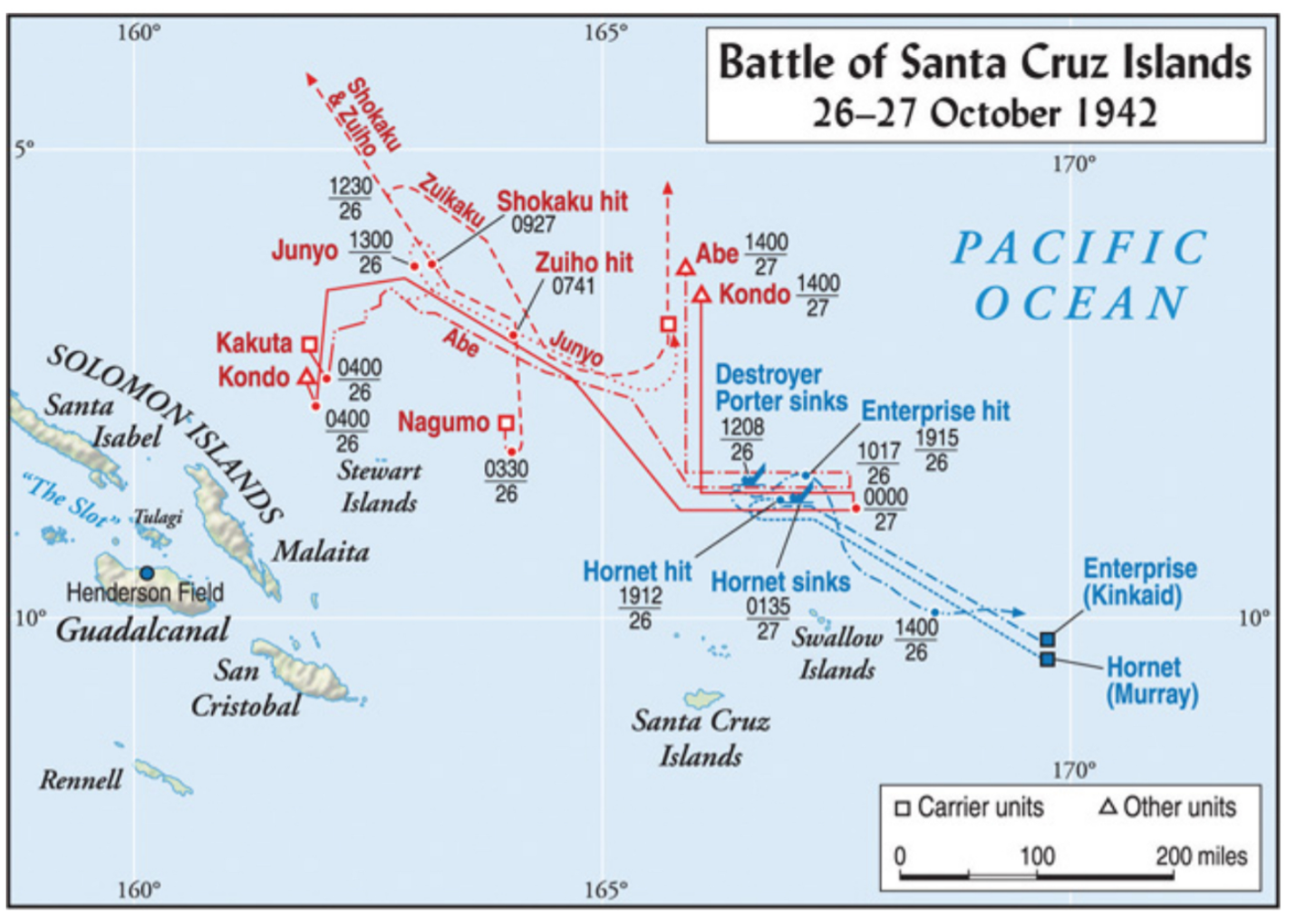
An attempt was made to achieve operational integration between naval carriers and their airwings with other services called Air-Sea Battle. The concept was born from a collaboration between the Navy and Air Force in 2009 to address the challenge of China’s capabilities by developing and practicing new joint tactics.24 However, it failed to gain traction and funding, and by January 2015, it had been folded into the Joint Staff, effectively sideling the effort.25 In a January 2023 article, Admiral James Foggo and Steven Wills argued for resurrecting the Air-Sea Battle, given developments in long-range weapons advances in networks.26 The time is ripe for a relook. After all, achieving effective operational tessellation of the Western Pacific requires a high degree of integration. The carrier and its airwing will be a critical, mobile platform enabling significant sensors-weapons tessellation of the battlefield. The carrier and its airwing must be seamlessly integrated with land and space-based platforms and sensors to overcome China’s significant sensor and missile threats. This will require technological advances as advocated by the proponents of Mosaic Warfare, but also developing the operational rigor learned through a new series of fleet problems backed by a resurrected Air-Sea Battle initiative.
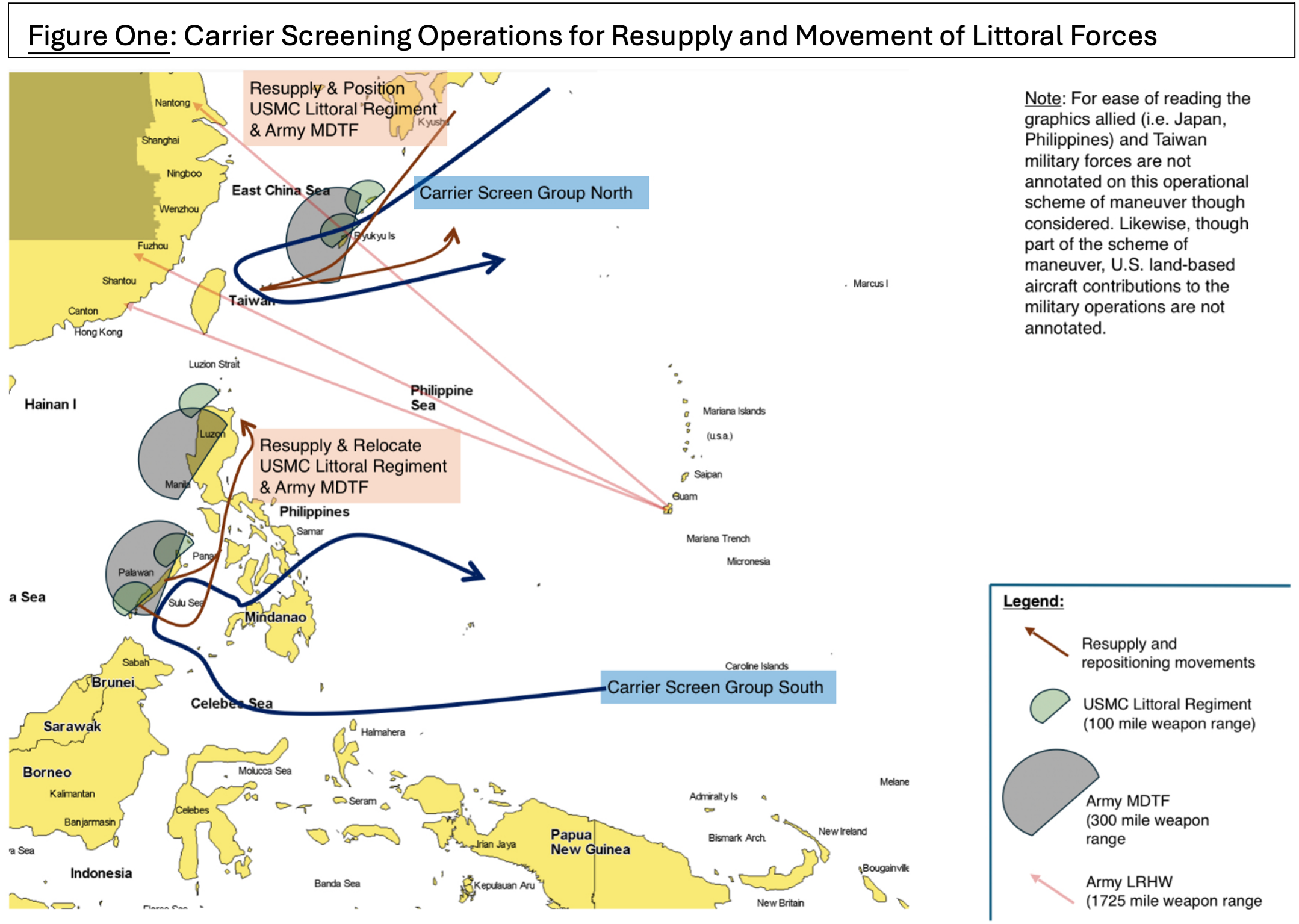
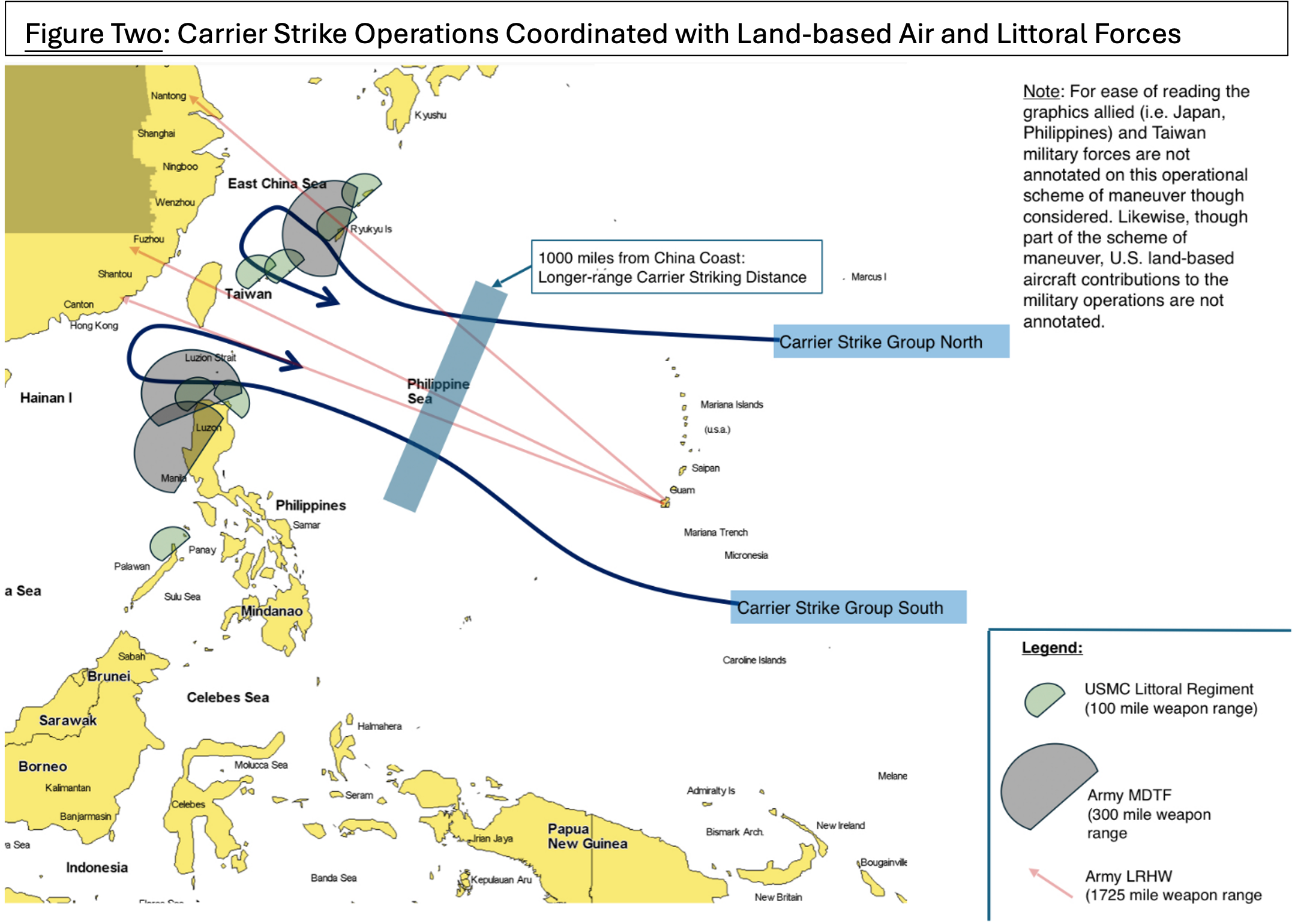
Conclusion
The good thing is that the technology being proven now on Ford, like the advanced arresting gear and electromagnetic aircraft launch systems, provides the flexibility needed for deploying a wider range of aircraft with future munitions. The key will be how well these systems have performed recently in the Eastern Mediterranean during the ship’s 2023 deployment. This information will inform decisions for future carrier and airwing designs and operations that maximize flexibility and adaptability – a core feature and advantage of the aircraft carrier stretching back to its origin.
Captain Brent Sadler (Ret.) joined the Heritage Foundation as a Senior Research Fellow in 2020 after a 26-year naval career in nuclear submarines and as a foreign area officer. He has extensive operational experience in the Western Pacific, having served at Seventh Fleet, Indo-Pacific Command, as Defense Attache in Malaysia, and as an Olmsted Scholar in Tokyo, Japan.
References
1. “Paris Naval Conference 2024: The Evolving Role of the Carrier Strike Group,” French Institute of International Relations, January 25, 2024 (accessed February 27, 2024).
2. Sam LaGrone, “Navy Refining Plan for its $17B Destroyer Electronic Warfare Backfit with 4 Test Ships,” USNI News, January 19, 2024 (accessed February 27, 2024).
3. E. B. Potter, Sea Power: A Naval History, second edition (Annapolis: U.S. Naval Institute, 1981), pg. 500-501.
4. David Hobbs, British Aircraft Carriers (Yorkshire: Seaforth Publishing, 2013), pg. 119-129.
5. Norman Friedman, U.S. Aircraft Carriers: An Illustrated Design History (Annapolis: Naval Institute Press, 1983), pg. 47.
6. Albert A. Nofi, To Train the Fleet for War: The U.S. Navy Fleet Problems, 1923-1940 (Newport: U.S. Naval War College Press, 2010). Pg. 109-126.
7. “USS Ranger (CV-4),” Naval History and Heritage Command, (accessed March 7, 2024).
8. “Structural Repairs in Forward Areas During World War II,” Bureau of Ships, December 1949, pg. 82-84, (accessed March 8, 2024).
9. Norman Friedman. U.S. Aircraft Carriers: An Illustrated Design History (Annapolis: Naval Institute Press, 1983), pg. 91 and 154-155.
10. Cid Standifer, “Sunk, Scrapped or Saved: The Fate of America’s Aircraft Carriers,” USNI News, August 18, 2014 (accessed May 1, 2024).
11. Thomas Heinrich, Warship Builders: An Industrial History of U.S. Naval Shipbuilding 1922-1945 (Annapolis: Naval Institute Press, 2020), pg. 91-92, 97-102 and 114-116.
12. Bureau of Ships, “Structural Repairs in Forward Areas During World War II,” U.S. Navy Department, December 1949, pg. 89-97, (accessed May 2, 2024).
13. “Electromagnetic Aircraft Launch System (EMALS),” Naval Air Systems Command (accessed May 2, 2024).
14. “DARPA Tiles Together a Vision of Mosaic Warfare: Banking on cost-effective complexity to overwhelm adversaries,” Defense Advanced Research Projects Agency (accessed May 1, 2024).
15. “Summary of the Joint All-Domain Command and Control Strategy,” Department of Defense, March 2022 (accessed May 2, 2024).
16. Andrew Feickert, “U.S. Marine Corps Force Design 2030 Initiative: Background and Issues for Congress,” Congressional Research Service, June 30, 2023, pg. 1,3,7 and 11, (accessed April 27, 2024).
17. “Marine Littoral Regiment,” U.S. Marine Corps, January 11, 2023 (accessed May 2, 2024).
18. “Marines Strike Ship With Pair of Naval Strike Missiles,” U.S. Marine Corps, August 21, 2021 (accessed May 2, 2024).
19. “2nd Battalion, 11th Marine Regiment Becomes First Marine Unit to Fire NMESIS Missiles,” U.S. Marine Corps, June 29, 2023 (accessed May 2, 2024).
20. Andrew Feickert, “Defense Primer: Army Multi-Domain Operations (MDO),” Congressional Research Service, January 2, 2024 (accessed April 27, 2024).
21. Andrew Feickert, “U.S. Army Long-Range Precision Fires: Background and Issues for Congress,” Congressional Research Service, March 16, 2021, pg. 16-18, (accessed May 2, 2024).
22. Andrew Feickert, “The U.S. Army’s Long-Range Hypersonic Weapon (LRHW): Dark Eagle,” Congressional Research Service, March 13, 2024 (accessed May 2, 2024).
23. Lars Celander, How Carriers Fought: Carrier Operations in World War II (Philadelphia: Casemate, 2018), pg. 158-171.
24. “Air-Sea Battle,” Air-Sea Battle Office, May 2013, pg. 4, (accessed May 2, 2024).
25. Sam LaGrone, “Pentagon Drops Air Sea Battle Name, Concept Lives On,” USNI News, April 27, 2024 (accessed May 2, 2024).
26. James Foggo and Steven Wills, “Back to the Future: Resurrecting ‘Air/Sea Battle’ in the Pacific,” Breaking Defense, January 24, 2023 (accessed May 2, 2024).
Featured Image: Eugene Ely flies his Curtiss pusher biplane from the USS Birmingham in Hampton Roads, Virginia, on Nov. 14, 1910, the first time an airplane took off from a U.S. warship. (Photo via Wikimedia Commons)

